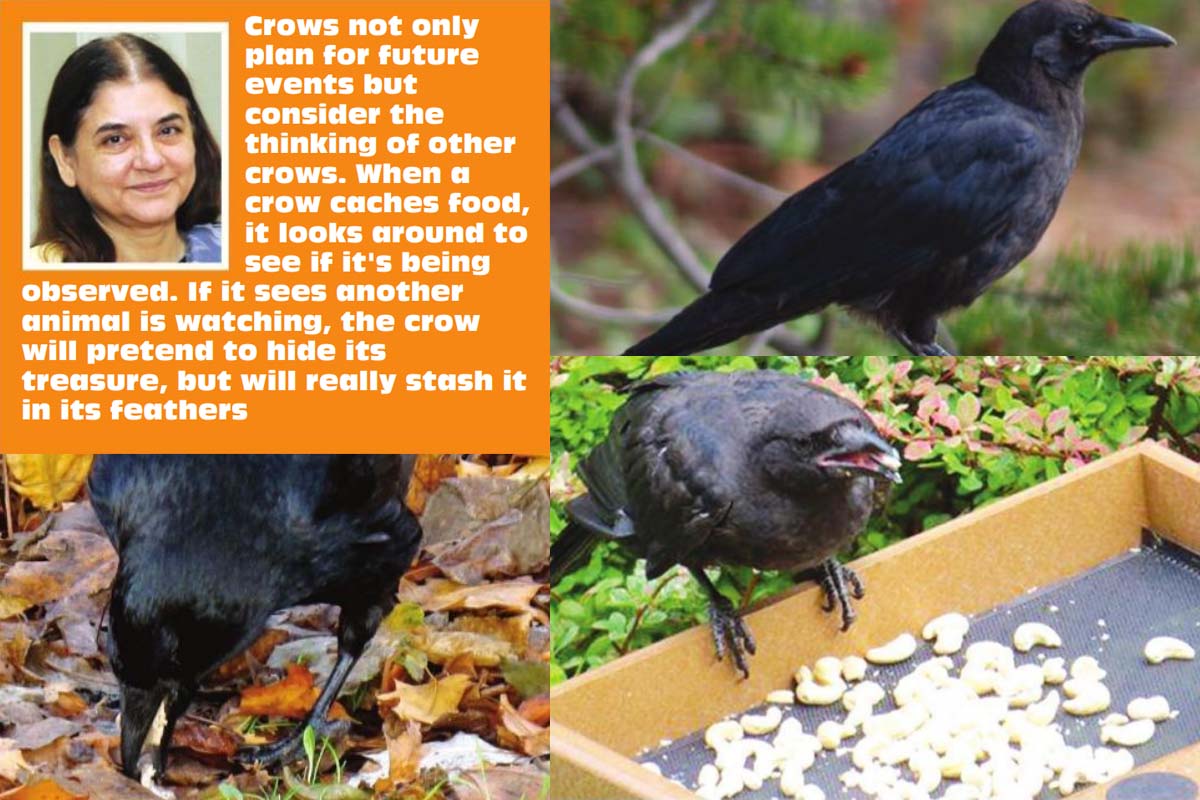Back to one of my favourite subjects: crows. They are slowly disappearing, so please save them now. Give them shelled peanuts, rice, fruit. Don’t put it on the ground. They prefer trays, open feeders, tables. Don’t stare at them because they will not pick up the food. Just leave it and retreat, and slowly, as they begin to trust you, you can start hanging around at a distance of about 8 feet and then close in.
Sometimes they leave gifts if you feed them. So if you like shiny objects and strange sticks keep feeding them. A young crow feeder called Gabi Mann has shown what the crows brought her on You Tube ‘The BitterSweet Life’: earrings, paper clips, nuts and bolts and a small light bulb.
Advertisement
They play the funniest games. Not just tag, tug-of-war with sticks and hide-and seek. For instance they will sit on a wire and suddenly one will flip upside down until he drops off and lands on the ground. Then he will go up and do the same thing. Just showing off! Young crows push each other off ledges; they throw snow at each other, sneak up behind another and unbalance them. They hang joyfully from branches, do elaborate aerial maneuvers.
Scientists have documented 7 kinds of play:
- Object play (manipulating things for no reason).
- Play caching (hiding inedible objects).
- Flight play (random aerial acrobatics).
- Bath play (more activity in water than necessary to get clean).
- Sliding down inclines (snowboarding, sledding, body sliding).
- Hanging (hanging off branches but not to obtain food).
- Vocal play (you know how kids go through that phase when they talk to themselves a lot? The crow version of that.)
Here are crow watchers writing in with their experiences:
“I watched one play with a leaf for 10 minutes, he’d sit on a power line moving it between his feet, then let it drop to the ground, fly down, pick it up, and repeat. I’ve also watched them thwack each other with pine boughs (pull back with beak or foot, wait until sibling isn’t looking and let go)”
“I observed some young crows at play in the restaurant parking lot beside our house. One day, there was a rolled up ball of paper or rags. And to my amazement these fun loving crows started to bat it back and forth across the parking lot to each other – as if playing football.”
“Ravens were discreetly approaching quokkas from behind to bite their tail, scare them and make them jump. It really looked like a game”
“I have seen them ‘steal’ bags of chips from inside a store, escape, open the bag and eat them like professionals!”
There are 40 species of crow all over the world. Most stay in groups. Others are solitary but will forage in groups. When one crow dies, the group will surround the deceased. This funeral isn’t just to mourn the dead, but also to see what killed their member. They band together and chase predators in a behavior called mobbing. They live close to where they are born, and help raise and defend chicks.
Ravens send out calls to alert other individuals to sources of food. Researchers Boeckle, Szipl, and Bugnyar published in Frontiers in Zoology, have shown that ravens encode their age and sex in these calls, so that individuals can decide whether to join the feeding event. This decision is particularly important because aggression at feeding events can cause injury, so grouping with a bad crowd can come at a high price.
Crows have trust issues with human beings, but once they trust you they adopt patterns of behaviour. For instance they will wait for a husband’s car to leave before they come to be fed by the wife! A crow watcher from Ireland has observed that when he started, his wife would bring him food and he threw some of it to the crows. After a few days they would come just before his wife turned up, and squawk to let him know she was coming.
Like humans, crows plan for the future. They store tools for later use, cache food, and only hide those pieces of food that they know will be running low in the future. In all these studies, the birds had to consider what to do, where to do it, and when to prepare for certain specific future events.
In a study published in the journal Science, researchers tested whether the birds could store and retrieve a tool to get at their food after a gap of 17 hours. The ravens were able to instantly select the tool from a number of unnecessary items.
In another experiment researchers taught ravens to select a token that they could exchange for food. The ravens showed that they were able to select it, store it and then retrieve and use it, many days later, in exchange for food. This does not happen in nature, but the birds understood the concept immediately.
This proves that they don’t just use abilities that have evolved naturally, but can flexibly and intelligently apply new solutions. Crows not only plan for future events but consider the thinking of other crows. When a crow caches food, it looks around to see if it’s being observed. If it sees another animal is watching, the crow will pretend to hide its treasure, but will really stash it in its feathers. The crow then flies away to find a new secret spot. If a crow sees another crow hiding its prize, it knows about this little game and won’t be fooled. Instead, it will follow the first crow to discover its new hoard. Ravens pretend to hide things simply to see who is following them, so that they know who is most likely to steal their cache once they’re actually hiding food.
Another case of crow memory comes from Chatham, Ontario. Around half a million crows would stop in Chatham on their migration route. The mayor of the town declared war on crows because of their droppings, and people started shooting them. Since then the crows have bypassed Chatham, flying high enough to avoid being shot. This had not, however, stopped them from leaving droppings all over the municipality.If you think two crows watching you and cawing at each other are talking about you, you’re probably right. In Marzluff’s study, even crows that were never captured attacked scientists who had captured other crows previously. How did the crows describe their attackers to other crows? The intensity, rhythm, and duration of caws form the basis of a possible language. Ravens have a language with 33 categories of recorded vocalizations.
They watch what we do and learn from us. Crows have been seen to drop nuts in traffic lanes, so cars will crack them open. They watch traffic lights, only retrieving the nut when the crosswalk sign is lit. Crows have been known to memorize restaurant schedules and garbage days, to take advantage of prime scavenging times. They are one of the few animals to recognize themselves in the mirror. Please start feeding them today.











